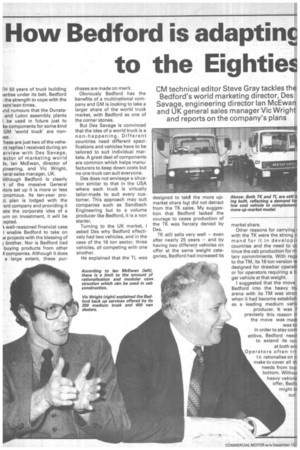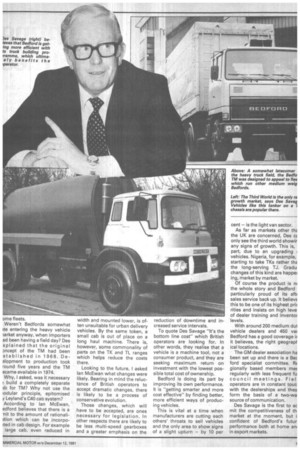How Bedford is adaptinc to the Eighties
Page 36

Page 37

If you've noticed an error in this article please click here to report it so we can fix it.
CM technical editor Steve Gray tackles the Bedford's world marketing director, Des Savage, engineering director Ian McEwan and UK general sales manager Vic Wright and reports on the company's plans
FH 50 years of truck building iertise under its belt, Bedford ; the strength to cope with the rent lean times.
,nd rumours that the Dunstaand Luton assembly plants I be used in future just to ke components for some kind GM 'world truck' are nonse.
'hese are just two of the vehent replies i received during an erview with Des Savage, ector of marketing world le, Ian McEwan, director of jineering, and Vic Wright, ieral sales manager, UK.
klthough Bedford is clearly -t of the massive General 'tors set up it is more or less :onomous. Its ten-year proat plan is lodged with the -ent company and providing it :ets the corporate idea of a urn on investment, it will be :epted.
N, well-reasoned financial case I enable Bedford to take on IN projects with the blessing of j brother. Nor is Bedford tied buying products from other companies. Although it does a large extent, these pur
chases are made on merit.
Obviously Bedford has the benefits of a multinational company and GM is looking to take a larger share of the world truck market, with Bedford as one of the corner stones.
But Des Savage is convinced that the idea of a world truck is a non-happening. Different countries need different specifications and vehicles have to be tailored to suit individual markets. A great deal of components are common which helps manufacturers to keep down costs but no one truck can suit everyone.
Des does not envisage a situation similar to that in the USA where each truck is virtually tailor-made to suit every customer. This approach may suit companies such as Sandbach Engineering but to a volume producer like Bedford, it is a non starter.
Turning to the UK market, I asked Des why Bedford effectively had two vehicles, and in the case of the 16 ton sector, three vehicles, all competing with one another.
He explained that the TL was designed to takd the more upmarket share but did not detract from the TK sales. My suggestion that Bedford lacked the courage to cease production of the TK was fiercely denied by Des.
TK still sells very well — even after nearly 25 years — and by having two different vehicles on offer at the same weight categories, Bedford had increased its market share.
Other reasons for carrying 4 with the TK were the strong c mand for it in developir countries and the need to co tinue the cab production for m tary commitments. With rega to the TM, its 16 ton version w designed for drawbar operati; or for operators requiring a la; ger vehicle at that weight. I suggested that the move Bedford into the heavy tru arena with its TM was stran when it had become establish as a leading medium vehic producer. It was f precisely this reason tlthe move was madi was to In order to stay corn etitive, Bedford need to extend its rail at both enc Operators often tri to rationalise on o make to cover all th needs from top bottom. Withou heavy vehicle offer, Bedfc might lo out o me fleets.
Weren't Bedfords somewhat ite entering the heavy vehicle rarket anyway, when importers ad been having a field day? Des xplained that the original D ncept of the TM had been stablished in 1968. Dealopment to production took round five years and the TM ecame available in 1974.
Why, I asked, was it necessary ) build a completely separate )b for TM? Why not use the iodular principle, epitomised
Leyland's C40 cab system? According to Ian McEwan, edford believes that there is a -nit to the amount of rationalirtion which can be incorpoited in cab design. For example large cab, even reduced in
width and mounted lower, is often unsuitable for urban delivery vehicles. By the same token, a small cab is out of place on a long haul machine. There is, however, some commonality of parts on the TK and TL ranges which helps reduce the costs there.
Looking to the future, I asked Ian McEwan what changes were likely. Bearing in mind the reluctance of British operators to accept dramatic changes, there is likely to be a process of conservative evolution.
Those changes, which will have to be accepted, are ones necessary for legislation. In other respects there are likely to be less multi-speed gearboxes and a greater emphasis on the reduction of downtime and increased service intervals.
To quote Des Savage "It's the bottom line cost" which British operators are looking for. In other words, they realise that a vehicle is a machine tool, not a consumer product, and they are seeking maximum return on investment with the lowest possible total cost of ownership.
Bedford is doing its part by improving its own performance. It is "getting smarter and more cost effective" by finding better, more efficient ways of producing vehicles.
This is vital at a time when manufacturers are cutting each others' throats to sell vehicles and the only area to show signs of a slight upturn — by 10 per cent — is the light van sector.
As far as markets other thE the UK are concerned, Des a only seethe third world showir any signs of growth. This is, part, due to an upgrading vehicles. Nigeria, for example, starting to take TKs rather thE the long-serving TJ. Gradu changes of this kind are happei ing, market by market.
Of course the product is nr the whole story and Bedford particularly proud of its aft( sales service back up. It believE this to be one of its highest prir rities and insists on high leve of dealer training and inventor 'levels.
With around 200 medium dui vehicle dealers and 450 vat Bedford has a good coverage it it believes, the right geograpt ical locations.
The GM dealer association ha been set up and there is a Be( ford specialist committee. RE gionally based members meE regularly with less frequent fu council meetings. Fiel operators are in constant touc with the dealerships and thes form the basis of a two-wa source of communication.
Des Savage is the first to ac mit the competitiveness of th market at the moment, but i confident of Bedford's futur performance both at home am in export markets.










































